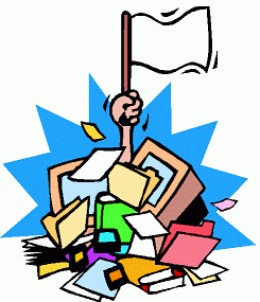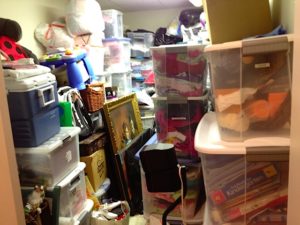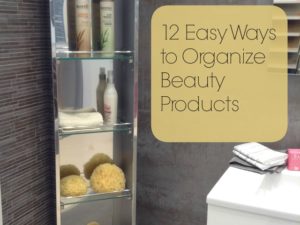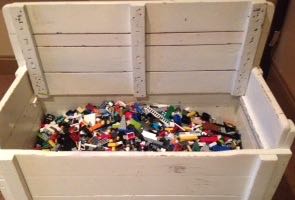 “I’m cleaning out my parents’ home and coming across lots of items with sentimental value, how do I decide what to keep?” A friend asked me this question recently. Like so many of us will do in our middle years, she’s facing the dual challenge of grieving while dispersing all of her parents’ possessions. If she’s also the executor of her parents’ estate, she’ll have bills, paperwork, and the responsibility of staging and selling the home as well. It’s a lot to handle at a fragile time. The key to getting through this is to do it in waves, as you have the time and energy.
“I’m cleaning out my parents’ home and coming across lots of items with sentimental value, how do I decide what to keep?” A friend asked me this question recently. Like so many of us will do in our middle years, she’s facing the dual challenge of grieving while dispersing all of her parents’ possessions. If she’s also the executor of her parents’ estate, she’ll have bills, paperwork, and the responsibility of staging and selling the home as well. It’s a lot to handle at a fragile time. The key to getting through this is to do it in waves, as you have the time and energy.
Below are some suggestions on how to handle the process.
Remove items associated with your parents’ illness. Unless the death was sudden, there’s likely some assortment of medications and medical equipment. Getting these out of the way first will help you release the more recent painful memories and make space for joyful memories to surface. Check Earth911 for places that will accept these items. Some charities and thrift stores, such as Care & Share Thrift Shoppes in Souderton, PA accept medical equipment.
Locate and have the executor disperse any property according to your parents’ wills. If you can’t find some of the items, make a list and leave it in a prominent location. You’ll likely come across the remaining items as you continue to work through the house.
Give away or donate everyday items that don’t hold any particular sentimental value. Usually a fair amount of clothing, kitchen items, books, knick-knacks, small furniture, linens, and items in deep storage (attic/garage/basement) fall into this category. Continue to keep any individual items that you’re unsure about.
At this point, most of what will be left has a chance of being important to you or your family. If you have the luxury of time, invite your relatives to your parents’ home for a ‘claiming memories day‘. Disperse any remaining items mentioned in the will, and open everything else to be given away as keepsakes. The executor may want to set some parameters for this, such as taking turns. Many families find that storytelling naturally emerges from this process. You’ll probably have a lot of tears and laughter. Don’t rush; it’s a precious part of the healing process.
Can you give yourself a little more time at this point? If so, take a break. You’ve fulfilled the requirements of the will, disposed of unnecessary items, and preserved the most important memories. More often than not, some rest and a return to your normal schedule will restore your resilience, stamina, and creativity.
When you’re ready to return to your parents’ home, it probably won’t feel so emotionally charged or overwhelming. You’ll have the confidence of knowing that you won’t accidentally destroy a precious artifact, stumble across an unpleasant memory, or be overwhelmed with unimportant things. In short, you’ll be dealing with the middle ground of your parents’ possessions.
As you work your way through these remaining items, ask yourself a few questions:
-Do I need this to stage the house?
-If I take it home, would I definitely use it?
-Do I know anyone who could use this?
-What charities did my parents support? Do they accept donations?
You’ll likely end up donating or giving away most of these final items. Keep reminding yourself that you already saved the most important things. As the house empties, you may be sad. That’s healthy. Do the work that is easier for you and harder for your family, and ask them to do the same for you. Be gentle with yourself and each other.
Most importantly, cherish your memories as they are the most important thing you’ll keep.
 Believe it or not, it only takes a few steps to get your online files organized. Below are seven steps to help you save countless hours and avoid those embarrassing situations that come from searching for lost files. Let’s get started!
Believe it or not, it only takes a few steps to get your online files organized. Below are seven steps to help you save countless hours and avoid those embarrassing situations that come from searching for lost files. Let’s get started!
1. Start at the Root
Determine where you want your file system to live on your computer. Having all your files and documents under one ‘root’ folder on your computer will make it easy to locate your files. Many single Windows users have all their folders, files, and documents stored haphazardly in the ‘Documents’ or ‘My Documents’ folder on their PC. If this sounds like your system, then you might want to consider starting from scratch. The easiest way to do this is to save all your current folders, files, and documents to a new folder and name it something like Archive_2015 or any appropriate name that’s easy to remember. Now you can start to create a new file structure with broad categories without losing any of your current information. After your new filing system is created, you can move previously created files and documents to the newly created system on an as needed basis.
2. Create a File Structure
File structure is the backbone of your filing system and it begins with using folders for general categories. Think big when creating filing categories and limit the number of folders to a critical few. Describe the contents of the folders with short commonly used, meaningful terms. Start broad and get more specific as you add files and documents to those broad category folders.
Examples for business folder names:
Administration
Clients
Financial
Insurance
Legal
Marketing
Organizations
Sales
Vendors
Projects
Examples for personal folder names:
Financial
Medical
Health & Wellness
Housing
Insurance
Taxes
3. Use Sub-Categories
After you have created your folders using broad categories, you will want to create files with sub-categories. Sub-categories are used to organized those files and documents within your folders. You may have a folder called ‘Projects’ and within that folder are several files or sub-categories called Project-A, Project-B and Project–C.
4. Determine a Naming Convention
It’s important to name your folders and files consistently and logically. Storing multiple drafts of the same document can get confusing, and a naming convention is one way to avoid that confusion. Also, adding a date at the end of the file name is a great way to keep track of multiple documents, and the addition of initials at the end of the file name will add clarity if more than one person is working on the same document.
Naming convention examples:
Jane_Doe
Jane_Doe_1/1/15
Jane_Doe_1/1/15_JD
5. ‘Save As’ You Go
File your documents in the proper location by using the ‘Save As’ feature. ‘Save As’ allows you to save and file your documents as you go, so they will be placed in the correct file or folder from the start.
6. Clean Up Your Desk Top
Evaluate what you really use and delete those icons or shortcuts that are outdated or infrequently used. Note: deleting a shortcut is not the same as deleting a file, folder or program from your computer. Deleting the shortcut will simply remove it from your desktop. A program like Fences is a great way to automatically sort out all those remaining icons into organized, easy to see boxes and categories. The program can sort the categories for you or you can create your own categories.
7. Backup Your Files
Have a regiment in place to regularly back up your files. If your hard drive fails or is damaged and your only source of backup is your computer, then you risk losing all of your business transactions and correspondence. The rule of thumb for data protection is “if you need it to run your business, then back it up.” Having all your files saved to a ‘root’ will make that process easy.
 Have you heard the term situational disorganization? What is it and how does it happen?
Have you heard the term situational disorganization? What is it and how does it happen?
Situational disorganization is when an event occurs that we cannot control and we are not prepared for, causing our organizational systems to fall apart.
The cause can be as simple as returning from vacation to find that there is a flood in the basement. Everything needs to be moved or thrown out; the space needs to be repaired and workers are coming in and out. In the meantime, everything gets out of control. Sometimes a second crisis will come up, an illness, an elderly parent gets sick or needs to move…something that needs your immediate and ongoing attention. It becomes more than you can handle. Priorities need to be reassessed and action taken on the priorities. Sometimes your organization falls to the bottom of the priority list. Situational disorganization.
People will often blame themselves. They feel that they should be able to maintain their systems. Since it is situational, it is temporary. When the issue is resolved, it will be time gather your resources and get reorganized.
I have experienced this so many times, personally and with my clients. When my mother-in-law downsized at the same time I was moving, I ended up with a 20×17’ room full of furniture. I could have opened a store. It took a couple of months to sort through and decide what we were going to keep, sell and donate. Then we had to assign homes for what we were keeping. Situational disorganization.
When I broke my wrist earlier this year, I had limited use of my right hand and could not put things away. I would put items on a table, and as my mobility improved, I would put them away. This went on for about three weeks and there was a lot to put away. Situational disorganization.
Other causes of situational disorganization that I have seen are: a client being treated for cancer while undergoing a home renovation; people blending households; a business taking off before the owners were ready; a caretaker prioritizing a parent’s health, resulting in bags and bags of paper after five years of caregiving; a divorce resulting in depression and an inability to manage the home; and accidents leaving people physically unable to deal with day-to-day activities for a period of time.
This may be you. If it is…know and plan that when you get through the crises that led you here, you will get back to your familiar, organized world!
 Organizing your beauty products will cut down on the time it takes to get ready in the morning and will start your day off on an organized, empowered note. Here are 12 easy ways to get started:
Organizing your beauty products will cut down on the time it takes to get ready in the morning and will start your day off on an organized, empowered note. Here are 12 easy ways to get started:
1. Keep only the items you use every single day in your medicine cabinet. Leave room for the basics like your toothbrush and skincare. At least that part of your routine can be simplified to just one product for each step, even if you have a million choices for color and finishing touches.
2. For beauty items that coordinate with your outfit or the season, like blushers, eye shadows, and lip color, group them together by category so you can see your choices at a glance.
3. Use clear acrylic drawer dividers or decorative boxes to hold groups of each makeup type in drawers or on shelves.
4. Use wall space by adding bins like those found in kitchens to hang utensils. Add magnetic or hook and loop (Velcro) fasteners to hang items in plain view on the back of the medicine cabinet door. The back of the bathroom door can offer even more storage space with the addition of a clear see-through shoe pocket organizer.
5. The under-sink space is super-high value real estate. Use a 2-tier sliding organizer to make use of all the room under your sink, and to reduce spills and messes.
6. Minimize the amount of beauty product in your tub area. Find a shampoo and body wash that the whole family enjoys using rather than tripping over multiples.
7. Most tubs don’t have much built in storage. Add racks that hang over the shower head and offer 2-4 shelves to hold beauty products and gear. Or suspend another shower rod on the inside back wall at eye level to hold baskets that can hold even more beauty items or bath toys.
8. The 80/20 rule applies to most beauty products. We usually use 20% of our products 80% of the time, and most products get used barely at all. Decide which items are your favorites, and pack the rest away for a month. If you don’t go back into the box to retrieve any of those items, you can probably do without them altogether.
9. Repurpose whenever possible. Use mason jars, wooden boxes that were original packaging for nicer beauty products, and small tin pails from the garden department to help you sort items together and make them look nice.
10. Even simple plastic bins from the dollar store can look great if they are in the same color scheme and labelled nicely.
11. Update your light bulbs. It’s hard to organize what you can’t see.
12. If you are updating your space, ensure there are plenty of drawers to store your beauty products in. Most basic vanities don’t come with drawers. With drawers, you can easily separate your beauty stash and keep your counters clear so you have room to prep each morning.
 With being a mother of three boys, it comes as no surprise that we have a toy box ‘filled to the brim’ with LEGOs. That’s right, every color, shape, and size ever put on the market from 1998 until 2010. I have over 12 years of memories concealed in this toy box. So, when my boys suggested that we ‘get rid’ of the LEGOs, I admit that my heart sank a little bit. Immediately, I thought of the countless hours my boys spent imagining, creating, and building their creations and my constant amazement how these little blocks could hold one’s attention for so long. The actual toy box was my husband’s from his childhood. This in and of itself is a family ‘heirloom.’ So, does it make sense to discard this ‘treasure trove’ that I hold so dear? You would think that as a Professional Organizer it would be a ‘no brainer’…not so much.
With being a mother of three boys, it comes as no surprise that we have a toy box ‘filled to the brim’ with LEGOs. That’s right, every color, shape, and size ever put on the market from 1998 until 2010. I have over 12 years of memories concealed in this toy box. So, when my boys suggested that we ‘get rid’ of the LEGOs, I admit that my heart sank a little bit. Immediately, I thought of the countless hours my boys spent imagining, creating, and building their creations and my constant amazement how these little blocks could hold one’s attention for so long. The actual toy box was my husband’s from his childhood. This in and of itself is a family ‘heirloom.’ So, does it make sense to discard this ‘treasure trove’ that I hold so dear? You would think that as a Professional Organizer it would be a ‘no brainer’…not so much.
Do I purge on a regular basis? Yes. Although it comes naturally to me, I do try and live what I so often preach to my clients. “If it is no longer useful to you, why not bless someone with what you are no longer using?” Well, every now and then, sentimentality wins out. I am as sentimental as the next person and treasure certain items dearly. That being said, every item cannot and should not fall under this category. So, how does one choose?
First, you should ask yourself if the item holds good memories and brings you joy. If so, find a spot in your home to enjoy this treasure. Over the years, I have been gifted with many items from family, but have only kept what is useful to me. Take for instance your grandmother’s china. Maybe you have another set of fine china that appeals to you. If this is the case, donate or gift your grandmother’s set to someone else.
Second, take your storage space into consideration when deciding on what to keep. It does not take long for clutter to accumulate, and there is nothing worse than living in a cluttered environment. Also, if you can’t find the treasures when you want to use them, why hold onto them in the first place?
So, you’re probably wondering if I still have the white, wood toy box. The answer is yes! While my boys obviously don’t partake in building with LEGOs any longer, I have had on occasion, certain visitors who have enjoyed them. Also, it is located in our basement that was once our ‘toy room’ but has since been renamed the ‘workout’ room. Every now and then I get a glimpse of the toy box filled with LEGOs and my heart swells with wonderful memories of ‘years gone by.’
Forget Google! Professional Organizers have a plethora of resources to share with you ranging from recycling centers to special events happening in your area. Here are my favorites:
Consignments shops
~The Attic, Manayunk
“Here at The Attic we aim to provide a fun and engaging environment while also offering advice on modern and vintage trends.”
4335 Main St., Manayunk, PA 19127
Phone: 215-482-0300
~Greene Street, Manayunk
“Since Greene Street opened its doors in 1997, we have been working to offer affordable fashion in a clean, organized, and modern setting.”
4313 Main St., Philadelphia, PA 19127
Phone: 267-335-5478
Donations
This is a huge store which earned the nickname the “Pechin Street Boutique.”
4555 Pechin St., Philadelphia, PA 19128
Phone: 215-483-3340
 ~Colonial Neighborhood Council
~Colonial Neighborhood Council
“Colonial Neighborhood Council operates “The Well,” a thrift store offering a household items and clothing for adults and children.”
107 E. 4th Ave., Conshohocken, PA 19428
Phone: 610-828-6595
Recycling
“Recycling Kiosks — Every U.S. Best Buy store has kiosks, just inside the front doors, to drop off ink and toner cartridges, rechargeable batteries, and wires, cords and cables, plastic bags and gift cards.”
~Whole Foods Market, Plymouth Meeting (the biggest & nicest store I have ever s een)
een)
Recycle batteries, cork, plastic bags, Brita filters, yogurt cups & plastics #5
500 W. Germantown Pike, Plymouth Meeting, PA 19462
Phone: 610-832-0010
Events
~Household Hazardous Waste Collection
Saturday, May 30- Montgomery County Community College
340 DeKalb Pike (enter campus at 595 Cathcart Road), Blue Bell, PA 19422
~Paper Shredding
Saturday, August 15 (9am – noon)- Abington Junior High School
2056 Susquehanna Road, Abington, PA 19001
~Tire Collections
Saturday, June 6- from 9:00am – noon, Montgomery County Community College
340 DeKalb Pike, Blue Bell, PA 19422
~Finally, did you know about MedReturn Drug Collection Units? There is one at  the Montgomery County Courthouse.
the Montgomery County Courthouse.
2 E Airy St., Norristown, PA 19401
Phone: 610-278-3000
Some restrictions and fees may apply. Ask the Professional Organizer you hired. They’ll know!